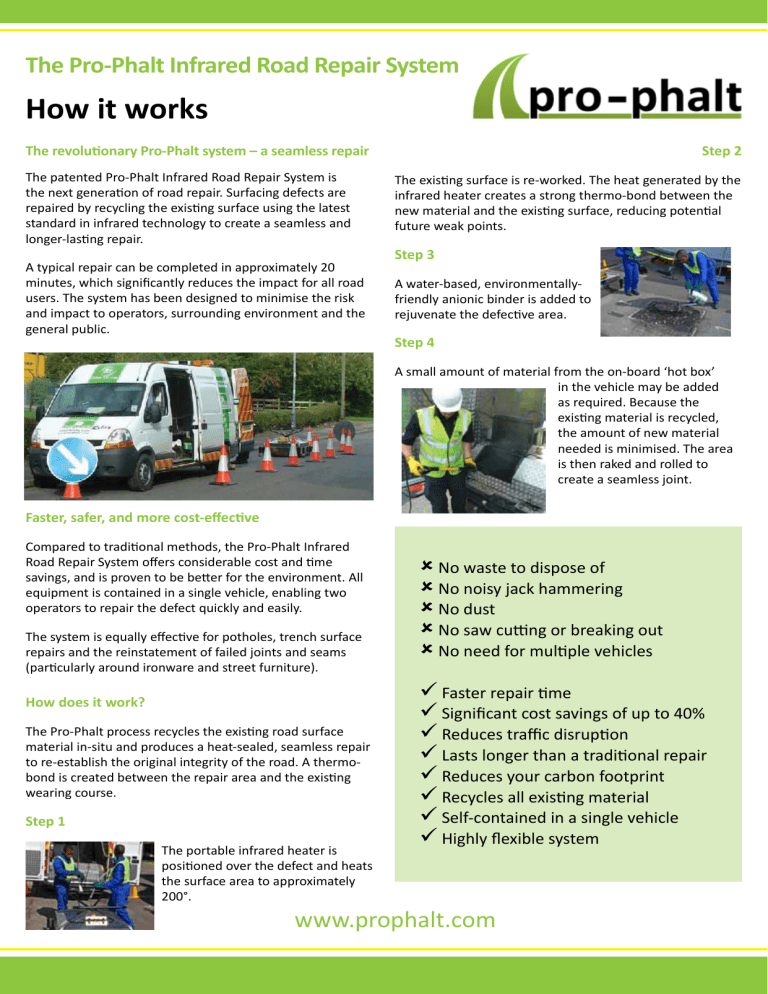
The Pro-Phalt Infrared Road Repair System How it works The revolutionary Pro-Phalt system – a seamless repair The patented Pro-Phalt Infrared Road Repair System is the next generation of road repair. Surfacing defects are repaired by recycling the existing surface using the latest standard in infrared technology to create a seamless and longer-lasting repair. A typical repair can be completed in approximately 20 minutes, which significantly reduces the impact for all road users. The system has been designed to minimise the risk and impact to operators, surrounding environment and the general public. Step 2 The existing surface is re-worked. The heat generated by the infrared heater creates a strong thermo-bond between the new material and the existing surface, reducing potential future weak points. Step 3 A water-based, environmentallyfriendly anionic binder is added to rejuvenate the defective area. Step 4 A small amount of material from the on-board ‘hot box’ in the vehicle may be added as required. Because the existing material is recycled, the amount of new material needed is minimised. The area is then raked and rolled to create a seamless joint. Faster, safer, and more cost-effective Compared to traditional methods, the Pro-Phalt Infrared Road Repair System offers considerable cost and time savings, and is proven to be better for the environment. All equipment is contained in a single vehicle, enabling two operators to repair the defect quickly and easily. The system is equally effective for potholes, trench surface repairs and the reinstatement of failed joints and seams (particularly around ironware and street furniture). How does it work? The Pro-Phalt process recycles the existing road surface material in-situ and produces a heat-sealed, seamless repair to re-establish the original integrity of the road. A thermobond is created between the repair area and the existing wearing course. Step 1 The portable infrared heater is positioned over the defect and heats the surface area to approximately 200°. û No waste to dispose of û No noisy jack hammering û No dust û No saw cutting or breaking out û No need for multiple vehicles ü Faster repair time ü Significant cost savings of up to 40% ü Reduces traffic disruption ü Lasts longer than a traditional repair ü Reduces your carbon footprint ü Recycles all existing material ü Self-contained in a single vehicle ü Highly flexible system www.prophalt.com Surfacing repair by infrared Better for roads, better for the planet The Scottish Institute of Sustainable Technology (SISTech) has officially recognised the Pro-Phalt system’s eco benefits in a recent report: The results show that the process has a significantly smaller carbon footprint than the traditional process, emitting less than one seventh of that of the traditional method per pothole repair. This has been achieved through a combination of lower operational energy use and lower resource consumption. As such the process can be recommended as preferable to the traditional process on the basis of CO2 emissions generated.” The infrared system control panel has four settings that activate the heater system. A series of infrared “pulse cycles” are generated, starting with short wave infrared to heat the air between the emitter and stabilise initial operating conditions. The next cycle is medium wave infrared that penetrates the upper layer or wearing course. Finally, long wave infrared penetrates the hole or crack and causes a reaction within the sub-base and base layers. The total operating cycle for the infrared is an average of just eight minutes. INFRARED EMITTER 1. SHORT WAVE INFRARED SISTech Carbon Footprint of the Pro-Phalt Process Report, 2007 ASPHALT WEARING COURSE BASE OR SUB STRUCTURE 2. MEDIUM WAVE INFRARED 3. LONG WAVE INFRARED Call Pro-Phalt today on 0027 (31) 9032021 for a free, no-obligation quote, or email info@prophalt.com for more information. www.prophalt.com




